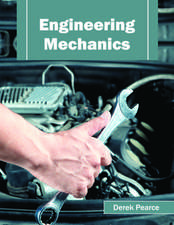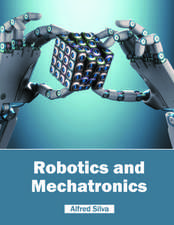Engineering Problem-Solving 101: Time-Tested and Timeless Techniques
Autor Robert Messleren Limba Engleză Paperback – 16 noi 2012
Publisher's Note: Products purchased from Third Party sellers are not guaranteed by the publisher for quality, authenticity, or access to any online entitlements included with the product.
MASTER UNIVERSAL ENGINEERING PROBLEM-SOLVING TECHNIQUES
Advance your engineering skills and become a capable, confident problem solver by learning the wide arrayof tools, processes, and tactics employed in the field. Going far beyond "plug-and-chug" solutions, thismultidisciplinary guide explains the underlying scientific principles, provides detailed engineering analysis,and lays out versatile problem-solving methodologies.Written by an "engineer who teaches," with more than 20 years of experience as a practicing engineer andnumerous awards for teaching engineering, this straightforward, one-of-a-kind resource fills a long-vacantniche by identifying and teaching the procedures necessary to address and resolve any problem, regardless of its complexity. Engineering Problem-Solving 101: Time-Tested and Timeless Techniques contains more than 50 systematic approaches spanning all disciplines, logically organized into mathematical, physical/mechanical, visual, and conceptual categories. Strategies are reinforced with practical reference tables, technical illustrations, interesting photographs, and real-world examples.
Inside, you'll find:
50+ proven problem-solving methods
Illustrative examples from all engineering disciplines
Photos, illustrations, and figures that complement the material covered
Detailed tables that summarize concepts and provide useful data in a convenient format
Preț: 357.48 lei
Preț vechi: 511.93 lei
-30% Nou
Puncte Express: 536
Preț estimativ în valută:
68.41€ • 70.06$ • 56.91£
68.41€ • 70.06$ • 56.91£
Carte tipărită la comandă
Livrare economică 20-26 martie
Preluare comenzi: 021 569.72.76
Specificații
ISBN-13: 9780071799966
ISBN-10: 0071799966
Pagini: 288
Dimensiuni: 208 x 254 x 13 mm
Greutate: 0.5 kg
Ediția:New.
Editura: McGraw Hill Education
Colecția McGraw-Hill
Locul publicării:United States
ISBN-10: 0071799966
Pagini: 288
Dimensiuni: 208 x 254 x 13 mm
Greutate: 0.5 kg
Ediția:New.
Editura: McGraw Hill Education
Colecția McGraw-Hill
Locul publicării:United States
Cuprins
Introduction
Ch 1. Engineers as Problem Solvers
Ch 2. Problem Solving Skills vs. Process vs. Techniques
Part I – Mathematical Approaches to Problem-Solving
Ch 3. Using Equations(“Plug and Chug”)
Ch 4. Approximating and Estimating
Ch 5. Interpolating and Extrapolating
Ch 6. Checking
Ch 7. Dimensional Analysis and Reconciling Units
Ch 8. Using Similarity and Ratios
Ch 9. Using Indexes or Indices
Ch 10. Scaling
Ch 11. Sensitivity Analysis (of Parameters)
Ch 12. Response Curves and Surfaces
Ch 13. Numerical Analysis & Methods
Ch 14. Dimensionless Quantities or Parameters
Ch 15. Assumptions, Constraints, Conditions, and Cases
Part II – Physical/Mechanical Approaches to Problem-Solving
Ch 16. Reverse Engineering
Ch 17. Material Property Correlations
Ch 18. Proof of Concept Models
Ch 19. Experimental Models and Model Experiments
Ch 20. Test Models and Model Testing
Ch 21. Mockups and Masters
Ch 22. Prototypes and Rapid Prototyping
Ch 23. Trial and Error
Part III – Visual, Graphic, or Iconic Approaches to Problem-Solving
Ch 24. Sketching and Rendering
Ch 25. Tracings and Transfers, Lofting and Lines-taking
Ch 26. Graphing and Graphical Methods
Ch 27. Layouts
Ch 28. Flow Diagrams or Flowcharts
Ch 29. Causal Diagrams (Fishbone or Ishikawa Diagrams)
Ch 30. Decision Trees
Part IV – Conceptual or Abstract Approaches to Problem-Solving
Ch 31. Brainstorming Process, Methodology and Techniques
Ch 32. Using Analogs
Ch 33. Dissecting Problems: Decoupling and Coupling, Zooming In and Zooming Out
Ch 34. Working Problems Backwards and Inverse Problems
Ch 35.FunctionalAnalysis&Black Boxes
Ch 36. Morphological Analysis and Morphological Charts
Ch 37. Storyboarding
Ch 38. Iteration and Iterative Design Process
Ch 1. Engineers as Problem Solvers
Ch 2. Problem Solving Skills vs. Process vs. Techniques
Part I – Mathematical Approaches to Problem-Solving
Ch 3. Using Equations(“Plug and Chug”)
Ch 4. Approximating and Estimating
Ch 5. Interpolating and Extrapolating
Ch 6. Checking
Ch 7. Dimensional Analysis and Reconciling Units
Ch 8. Using Similarity and Ratios
Ch 9. Using Indexes or Indices
Ch 10. Scaling
Ch 11. Sensitivity Analysis (of Parameters)
Ch 12. Response Curves and Surfaces
Ch 13. Numerical Analysis & Methods
Ch 14. Dimensionless Quantities or Parameters
Ch 15. Assumptions, Constraints, Conditions, and Cases
Part II – Physical/Mechanical Approaches to Problem-Solving
Ch 16. Reverse Engineering
Ch 17. Material Property Correlations
Ch 18. Proof of Concept Models
Ch 19. Experimental Models and Model Experiments
Ch 20. Test Models and Model Testing
Ch 21. Mockups and Masters
Ch 22. Prototypes and Rapid Prototyping
Ch 23. Trial and Error
Part III – Visual, Graphic, or Iconic Approaches to Problem-Solving
Ch 24. Sketching and Rendering
Ch 25. Tracings and Transfers, Lofting and Lines-taking
Ch 26. Graphing and Graphical Methods
Ch 27. Layouts
Ch 28. Flow Diagrams or Flowcharts
Ch 29. Causal Diagrams (Fishbone or Ishikawa Diagrams)
Ch 30. Decision Trees
Part IV – Conceptual or Abstract Approaches to Problem-Solving
Ch 31. Brainstorming Process, Methodology and Techniques
Ch 32. Using Analogs
Ch 33. Dissecting Problems: Decoupling and Coupling, Zooming In and Zooming Out
Ch 34. Working Problems Backwards and Inverse Problems
Ch 35.FunctionalAnalysis&Black Boxes
Ch 36. Morphological Analysis and Morphological Charts
Ch 37. Storyboarding
Ch 38. Iteration and Iterative Design Process















